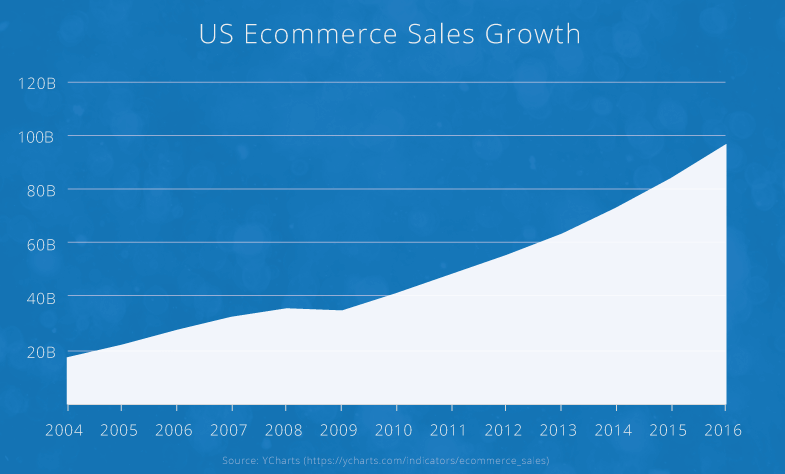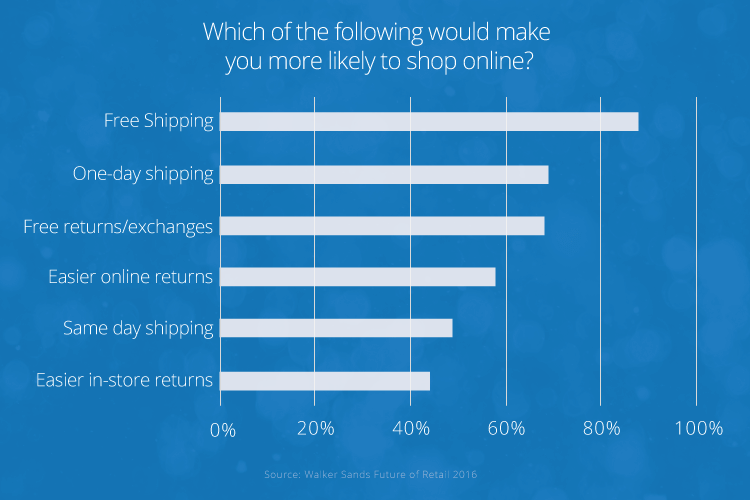
How to Offer Free Shipping the Right Way
Offering free shipping increases conversions, but when it's done poorly, it can hurt your bottom line. To do it right, you need to tailor it to your business.
A guy walks into a restaurant, sits down at the counter, and asks the waiter how much a cup of coffee costs.
“Three fifty,” says the waiter.
“How much for a refill,” asks the man.
“That’s free.”
“Fine, then, I’ll just have the refill.”
You and I both know there’s no such thing as a free cup of coffee. Somebody pays for every product or service you get.
The incredible thing is that consumers know there’s no free lunch, just as well as you know it. Then why do we like to pretend “free shipping” really exists, and why is it so powerfully effective?
In this article, we take a look at the free shipping paradox. We’ll talk about how best to offer free shipping, and how, when done the right way, it drives conversions and boosts bottom line profit.
Do You Really Have to Offer Free Shipping?
Studies conducted over the past five years consistently point to free shipping as the most effective promotional tactic available to ecommerce websites.
Prior to the growth of free shipping options for ecommerce stores, local retailers could counter the “I can get it cheaper online” objection with “Not after you add on the cost of shipping.”
Free shipping is a primary factor in the steady expansion of ecommerce sales. According to YCharts, online business grew from $27.8B for 2Q 2006 to over $97.3B during 2Q 2016.

And while the reality is that free shipping plans often fail to provide significant cost savings to consumers (the expense must be covered somehow), conversion rates typically take a healthy leap forward when free shipping is featured.
Conversion rates typically take a healthy leap forward when free shipping is featured. Click To TweetWhy do online sellers who offer free shipping get such great results? Here are some of the most cited reasons:
- Consumers don’t like surprises. They want to know the total price upfront. Making them go through the entire checkout procedure, before they can find out how much shipping will cost, presents an added burden and potential disappointment. You set up a situation quite likely to waste their time.
- “Free” is a perennially sweet word. If I can purchase your merchandise online and not have to drive to the local retailer, I save time. If you will ship to me at no cost, I’ve also saved money – certainly gas money, and it appears I’ve saved the shipping expense as well. The consumer’s inclination is, “I’ll pay a little more for the product, if you’ll pay for the shipping.”
- If you do something nice for me, I’m more inclined to do something nice for you… and free shipping is a really nice gesture. I will thank you with my business.
- The Baymard Institute puts the average cart abandonment rate at 68.8%. That’s more than two out of three. When shoppers were asked why they abandon the cart during checkout, 61% cited extra costs (i.e. shipping rate). The next biggest reason (account creation required) came in at 35%.
- Many consumers now choose where to shop based on whether or not free shipping is offered. A 2016 Walker Sands study reported 88% of respondents say free shipping is the top incentive for shopping online.

Given the almost undeniable conclusion that adding free shipping to the mix is a good idea for most businesses, the million-dollar question becomes “How can we offer free shipping and grow profitability at the same time?”
Let’s talk about that.
How to Offer Free Shipping While Increasing Profits
You don’t want to offer free shipping and lose money. Unfortunately, many businesses have done that, and some are still doing that. Your desire is to consider free shipping as an avenue towards a better return on investment.
Initially, you want to investigate the potential of free shipping for your particular business situation. You want to test free shipping or free shipping options before you make a commitment.
Free shipping, done right, typically boosts conversion rate, average order volume, customer retention, and profit.
Free shipping, done right, boosts conversion rate, avg. order volume, customer retention, and profit. Click To TweetThat’s your aim.
Here’s a three-step process to get started:
First Step: Take a snapshot of your current metrics. You’ll want to track conversion rate, average order volume, and net profit (at a minimum). Establishing a baseline is always the first step in testing. To begin, you are experimenting to see how changes in shipping will affect profit. You aren’t trying to optimize yet, you’re only taking a look at your options.
Second Step: Decide which free shipping offers you want to test. Most companies will want to experiment with carte blanche free shipping, free shipping for a minimum order amount, and free shipping under special conditions. See below for a list of ideas.
Third Step: Run the tests, observe and compare the data. If results warrant, you should then set up another set of tests to either do more discovery or begin the optimization process.
Enjoying this article?
Subscribe to our newsletter, Good Question, to get insights like this sent straight to your inbox every week.
The Variables to Consider When You Offer Free Shipping
You’ll want to adjust the second step (deciding which free shipping offers you want to test) to fit your unique situation.
Here are some of the options we’ve seen our clients utilize:
- Carte blanche free shipping – Some choose to increase prices to absorb the cost of shipping, while others take a hard look at profit margins and calculate how much extra sales volume would be required to make up for reduced profits per sale. It may also be that higher volume will qualify you for reduced shipping costs. Always work closely with shippers to get the best possible combination of cost and service.
- Free shipping with a minimum order – This is usually the more doable option. Customers who are close to reaching the order amount for free shipping will very likely tack on additional products to reach the required threshold. That, in turn, can push your average order value up considerably and help make up for the absorbed shipping cost. Typically, you want to set the minimum order higher than your current average order value. How high? That’s a good thing to test.
- Flat rate shipping – This isn’t a free shipping offer, but it does alleviate much of the shopper’s anxiety. Those who know what the shipping cost will be before loading up the cart are more likely to follow through and place the order than those who don’t know how much shipping costs will be until they’re ready to pay. This tactic is especially effective when higher-priced items are ordered. $5 flat rate shipping on a $150 order is far more attractive than $5 shipping on a $12 order.
- Free shipping to limited locations – Given the sometimes exorbitant cost of shipping abroad, many ecommerce stores will offer free shipping only to those in their own country. Another possibility here is to offer free shipping from the distribution center to a local retail outlet. Be sure to spell out which locations qualify for free shipping.
- Free shipping to members – Here’s a way to build loyalty and grow your mailing list. You can charge for membership or not, but helping people feel like they’re a part of your business and giving them a good reason for shopping with you are almost always good ideas. Amazon Prime is a great example of this model, but it could just as easily be only for those who subscribe to your email list (for free).
- Free shipping as a campaign – You can set aside a special time for free shipping and let people know in advance. You can even make the offer only to a special subset of your customer base and use it as a reward for loyalty or as an incentive for those who haven’t ordered in a while.
- Free shipping on select products – Some products lend themselves more to free shipping than others. Consider shipping costs and profit margins, then test free shipping on those items that make good financial sense. This method can also be implemented as a way to boost sales of items that are lagging.
- Free shipping on combinations of products – Some sellers use a complimentary item approach. For example, “When you buy the rod and reel together, we’ll ship for free.” Others use a variation of buy-one-get-one to encourage the purchase of multiple items.
Look carefully at your business. Choose two or three tactics, or combinations of tactics, to test.
Then set the parameters for those tests.
- If you choose a minimum order threshold, where should it be set?
- If you choose carte blanche shipping, are there ways to lower associated expenses so the profit margin doesn’t get gouged too deeply?
- If you will test with only a certain group of customers, how will you identify those people?
Chart your test out carefully. Know what you’re testing, who you’re testing it with, and what results you expect to see. You should also set cut-off points that will halt a specific test if metrics fall too rapidly or too far.
Further Considerations for Free Shipping Offers
We’ve already mentioned the possibility that increased shipping volume may qualify you for reduced shipping costs. Don’t wait for shippers to come to you with that news, though. Be proactive in your negotiations.
Make shippers compete for your business. Compare their prices and services on a regular basis. Maintain a relationship with the representatives who service your location. We’ve seen companies reduce shipping costs by more than a third, simply by comparing rates and asking.
You may be able to take a considerable amount of sting out of free shipping by getting your shipping rates reduced.
Another thing to stay on top of is the cost of shipping each of your products. Shipping costs can change, and if the cost of shipping is larger than the profit margin on the item, you’ll lose money by selling it. That’s usually not good business, although there are times when long term customer value justify short term losses.
You Don’t Know Until You Try
Online shoppers often decide whether or not to consider doing business with you based solely on whether or not you offer free shipping.
Many ecommerce stores have discovered that incorporating free shipping as part of their strategic plan enables them to sell more goods and earn more profits.
Here at The Good, we’re always enthusiastic about testing. You’ll never know, for sure, what will happen if you begin to offer free shipping or decide to incorporate a variant of free shipping until you design an adequate experiment and try it for yourself.

About the Author
David Hoos
David Hoos is the former Director of Marketing at The Good, conversion rate experts who deliver more revenues, customers, and leads. David and the team at The Good have made a practice of advising brands on how to see online revenue double through their conversion rate optimization services.